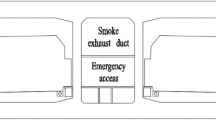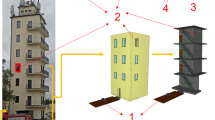Abstract
Since the Fall of 1992, the University of Central Florida (UCF) and the Orange County Fire Rescue Division (OCFRD) have conducted a joint research program to evaluate the effectiveness of positive pressure ventilation (PPV) as a firefighting technique. The objectives of the research program are to quantitatively measure temperature, air quality, and visibility during actual live fire exercises. Using the data from three residential fires, a novel technique was developed to conduct underwater, scale-model PPV simulations.
PPV is a technique that uses fans with high volumetric flow rates to create a slight positive gage pressure within a structure to force heat and combustion products from strategically selected exhaust openings. This rapidly reduces temperatures and retards the combustion process by hindering pyrolysis (the conversion of solid fuel to gaseous, combustible fuel). The removal of smoke improves visibility inside the structure, and the survivability potential for victims is increased by removing toxic gases, lowering temperatures, and introducing fresh air.
Results suggest that PPV is an effective technique that can be of significant value when properly applied. Results, specific to this program, that exemplify advantages of PPV include:
-
1.
Reduced temperatures for firefighters and victims. At key firefighting positions, for example, PPV contributed to temperature reductions from 860°F to 140°F within 1 minute.
-
2.
Improved air quality for firefighters. PPV was shown to contribute to oxygen addition and carbon monoxide removal.
-
3.
Faster smoke removal and faster restoration of visibility. When PPV was used, firefighters had water on a residential fire 6 minutes after it began and were walking upright in a cool, highvisibility environment. By contrast, 8 minutes after the start of a second, identical fire in which PPV was not used, firefighters were still crawling around in a hot, smoke-filled environment.
-
4.
Reversal of the direction of flames away from the firefighting location. For example, flashover flames that entered a hallway were pushed back into the burning room soon after the start of PPV.
-
5.
No spread of heat damage. Examination of lateral extent and depth of char on pine 2x4s placed in the path of the flames for PPV and non-PPV fires showed no spreading of heat or flame damage caused by PPV.
Full-scale PPV research and training can be expensive. During the course of this project, a technique was developed to conduct scale-model PPV simulation. The simulations are conducted underwater with transparent scale models of residences. The thermodynamics of the fire and the fluid mechanics of PPV are simulated by injecting colored water dyes at rates determined from actual fire measurements. Results from the residential fires colorfully illustrate that the spread of heat and the effects of PPV can be accurately and safely simulated in the laboratory.
Similar content being viewed by others
References
Hughes, L. D., “Positive Pressure Ventilation in a Test Setting,”Fire Engineering (December 1989), pp. 56–59.
Mittendorf, J. W., “Positive Pressure Ventilation: A New Angle,”American Fire Journal (January 1988), pp. 26–28.
Steckler, K. D., Baum, H. R., and Quintiere, J. G., “Salt Water Modeling of Fire Induced Flows in Multicompartment Enclosures,”NBSIR 86-3327, National Bureau of Standards, Center for Fire Research, Gaithersburg, MD, March 1986, and 21st Symposium on Combustion, The Combustion Institute, 143–149 (1986).
Ziesler, P. S., “Laboratory Simulation of Positive Pressure Ventilation,” Master's Thesis, University of Central Florida, July 1993.
Ziesler, P. S. and Gunnerson, F. S., “Simulation of Positive Pressure Ventilation (PPV) for Research and Training,” Fourth International Symposium on Fire Safety Science, Ottawa, Ontario, Canada, June 13–17, 1994.
Author information
Authors and Affiliations
Rights and permissions
About this article
Cite this article
Ziesler, P.S., Gunnerson, F.S. & Williams, S.K. Advances in positive pressure ventilation: Live fire tests and laboratory simulation. Fire Technol 30, 269–277 (1994). https://doi.org/10.1007/BF01040006
Issue Date:
DOI: https://doi.org/10.1007/BF01040006




